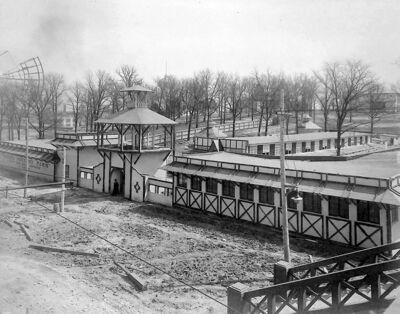Poultry Farm: Difference between revisions
No edit summary |
No edit summary |
||
| Line 13: | Line 13: | ||
| profit = | | profit = | ||
| owner = | | owner = | ||
| architect = | | architect = Carson, Hudson & Co., of St. Louis | ||
| dimensions = | | dimensions = | ||
| adult_entry = | | adult_entry = | ||
| Line 30: | Line 30: | ||
==Description== | ==Description== | ||
Thoroughbred, domestic fowls of every variety known, including water | |||
fowls, pheasants, pigeons, etc., can be seen in the Model Poultry Farm. The | |||
main object of the owners is to put the poultry business before the people | |||
of the whole world in a manner worthy of the importance of the industry, | |||
and in this way to promote the breeding of thoroughbred fowls. | |||
A secondary object is to teach the most approved methods of mating, incubating, | |||
breeding, etc., etc. | |||
In the main pavilion is an incubator cellar of 40 machines capacity, and | |||
chicks, ducklings, etc., will be hatched each day during the season. "These | |||
will be advanced through indoor and outdoor brooders and colony pens, beingmoved | |||
ahead one pen a day, until they are ready for the table. Then they | |||
will be scientifically fattened, killed and dressed, and served in the restaurant | |||
attached, where no meals except poultry and poultry products will be | |||
served. | |||
==After the Fair== | ==After the Fair== | ||
Latest revision as of 21:55, 9 January 2024
 | |
| Location | The Trail |
|---|---|
| No. of Buildings | 1 |
| Architecture | |
| Architect | Carson, Hudson & Co., of St. Louis |
It was a Model Poultry Farm.
Etymology[edit | edit source]
Before the Fair[edit | edit source]
Description[edit | edit source]
Thoroughbred, domestic fowls of every variety known, including water fowls, pheasants, pigeons, etc., can be seen in the Model Poultry Farm. The main object of the owners is to put the poultry business before the people of the whole world in a manner worthy of the importance of the industry, and in this way to promote the breeding of thoroughbred fowls. A secondary object is to teach the most approved methods of mating, incubating, breeding, etc., etc. In the main pavilion is an incubator cellar of 40 machines capacity, and chicks, ducklings, etc., will be hatched each day during the season. "These will be advanced through indoor and outdoor brooders and colony pens, beingmoved ahead one pen a day, until they are ready for the table. Then they will be scientifically fattened, killed and dressed, and served in the restaurant attached, where no meals except poultry and poultry products will be served.
